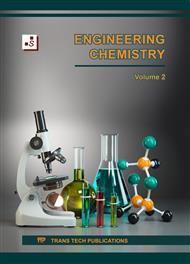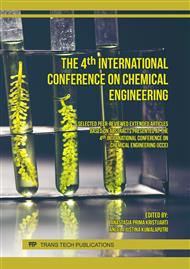[1]
S. Kaza, L. C. Yao, P. Bhada-Tata, and F. Van Woerden, What a Waste 2.0 : A Global Snapshot of Solid Waste Management to 2050. 2018.
DOI: 10.1596/978-1-4648-1329-0
Google Scholar
[2]
W. W. Y. Lau et al., "Evaluating scenarios toward zero plastic pollution," vol. 1461, no. September, p.1–6, 2020.
Google Scholar
[3]
C. Giacovelli, A. Zamparo, and A. Wehrli, "Single-use Plastics: A Roadmap for Sustainability." United Nations Environment Programme (UNEP), Nairobi, 2018.
Google Scholar
[4]
R. Geyer, J. R. Jambeck, and K. L. Law, "Production, use, and fate of all plastics ever made," Sci. Adv., vol. 3, no. 7, p.25–29, 2017.
DOI: 10.1126/sciadv.1700782
Google Scholar
[5]
J. Schiers and W. Kaminsky, Feedstock recycling and pyrolysis of waste plastics. Chichester: John Wiley & Sons Inc, 2006.
Google Scholar
[6]
N. Tangri and M. Wilson, "Waste Gasification & Pyrolysis: High Risk, Low Yield Processes for Waste Management A Technology Risk Analysis," no. March, 2017.
Google Scholar
[7]
F. Gao, "Pyrolysis of Waste Plastics into Fuels," University of Canterbury, 2010.
Google Scholar
[8]
J. A. Onwudili, N. Insura, and P. T. Williams, "Journal of Analytical and Applied Pyrolysis Composition of products from the pyrolysis of polyethylene and polystyrene in a closed batch reactor: Effects of temperature and residence time," vol. 86, p.293–303, 2009.
DOI: 10.1016/j.jaap.2009.07.008
Google Scholar
[9]
R. Miandad et al., "Catalytic pyrolysis of plastic waste: Moving toward pyrolysis based biorefineries," Front. Energy Res., vol. 7, no. MAR, p.1–17, 2019.
DOI: 10.3389/fenrg.2019.00027
Google Scholar
[10]
J. Aguado and D. P. Serrano, Feedstock Recycling of Plastic Wastes. Cambridge: The Royal Society of Chemistry, 1999.
Google Scholar
[11]
G. S. Kumar, V. R. Kumar, and G. Madras, "Continuous distribution kinetics for the thermal degradation of LDPE in solution," J. Appl. Polym. Sci., vol. 84, no. 4, p.681–690, 2002.
DOI: 10.1002/app.2344
Google Scholar
[12]
L. Quesada, M. C. de Hoces, M. A. Martín-Lara, G. Luzón, and G. Blázquez, "Performance of different catalysts for the in-situ cracking of the oil-waxes obtained by the pyrolysis of polyethylene film waste," Sustain., vol. 12, no. 13, p.1–15, 2020.
DOI: 10.3390/su12135482
Google Scholar
[13]
S. L. Wong, T. A. Tuan Abdullah, N. Ngadi, A. Ahmad, and I. M. Inuwa, "Parametric study on catalytic cracking of LDPE to liquid fuel over ZSM-5 zeolite," Energy Convers. Manag., vol. 122, p.428–438, 2016.
DOI: 10.1016/j.enconman.2016.06.009
Google Scholar
[14]
J. Shah, M. R. Jan, F. Mabood, and F. Jabeen, "Catalytic pyrolysis of LDPE leads to valuable resource recovery and reduction of waste problems," Energy Convers. Manag., vol. 51, no. 12, p.2791–2801, 2010.
DOI: 10.1016/j.enconman.2010.06.016
Google Scholar
[15]
S. Budsaereechai, A. J. Hunt, and Y. Ngernyen, "Catalytic pyrolysis of plastic waste for the production of liquid fuels for engines," RSC Adv., vol. 9, no. 10, p.5844–5857, 2019.
DOI: 10.1039/c8ra10058f
Google Scholar
[16]
G. Zattini et al., "Pyrolysis of Low-Density Polyethylene," Sustain. Des. Manuf., vol. 68, no. 2017, p.480–491, 2017.
Google Scholar
[17]
K. I. N. Dewi, A. Prasetya, , "Characteristics of Pyrolysis Oil Batch Polyethylene and Polysthyrene Plastic Waste," J. UGM, p.73–77, 2015.
DOI: 10.22146/ajse.v3i2.17163
Google Scholar
[18]
Cahyono, M. Sigit, and Ucik Ika Fenti. 2017. "Influence of Heating Rate and Temperature on the Yield and Properties of Pyrolysis Oil Obtained from Waste Plastic Bag." Conserve: Journal of Energy and Environmental Studies 1(1):1–8.
DOI: 10.30588/cjees.v1i1.248
Google Scholar
[19]
S. Koide, Y. Komatsu, and M. Shibuya, "Kerosene composition," 2004.
Google Scholar
[20]
B. Kunwar, H. N. Cheng, S. R. Chandrashekaran, and B. K. Sharma, "Plastics to fuel: a review," Renew. Sustain. Energy Rev., vol. 54, p.421–428, 2016.
DOI: 10.1016/j.rser.2015.10.015
Google Scholar
[21]
A. M. Elfadly, I. F. Zeid, F. Z. Yehia, M. M. Abouelela, and A. M. Rabie, "Production of aromatic hydrocarbons from catalytic pyrolysis of lignin over acid-activated bentonite clay," Fuel Process. Technol., vol. 163, p.1–7, 2017.
DOI: 10.1016/j.fuproc.2017.03.033
Google Scholar
[22]
L. V. Dagle, M. D. Flake, L. Lemmon, J. S. Lopez, L. Kovarik, and A. Dagle, "Effect of the SiO2 Support on the Catalytic Performance of Ag/ZrO2/SiO2 Catalysts for the Single-Bed Production of Butadiene from Ethanol," 2018.
DOI: 10.1016/j.apcatb.2018.05.055
Google Scholar
[23]
A. López, I. De Marco, B. M. Caballero, M. F. Laresgoiti, A. Adrados, and A. Aranzabal, "Applied Catalysis B: Environmental Catalytic pyrolysis of plastic wastes with two different types of catalysts: ZSM-5 zeolite and Red Mud," vol. 104, p.211–219, 2011.
DOI: 10.1016/j.apcatb.2011.03.030
Google Scholar
[24]
A. Galadima and O. Muraza, "In situ fast pyrolysis of biomass with zeolite catalysts for bioaromatics/gasoline production: A review," Energy Convers. Manag., vol. 105, p.338–354, 2015.
DOI: 10.1016/j.enconman.2015.07.078
Google Scholar
[25]
Z. Zhang, L. Zhang, F. Liu, Y. Sun, Y. Shao, and K. Sun, "Tailoring the surface properties of Ni / SiO2 catalyst with sulfuric acid for enhancing the catalytic efficiency for steam reforming of guaiacol," Renew. Energy, vol. 156, p.423–439, 2020.
DOI: 10.1016/j.renene.2020.04.012
Google Scholar
[26]
A. K. Panda, "Thermo-catalytic degradation of different plastics to drop in liquid fuel using calcium bentonite catalyst," Int. J. Ind. Chem., vol. 9, no. 2, p.167–176, 2018.
DOI: 10.1007/s40090-018-0147-2
Google Scholar
[27]
A. Karaduman and E. H. Şimşek, "Thermal degradation mechanism of low-density polyethylene plastic wastes in cyclohexane," J. Polym. Environ., vol. 9, no. 2, p.85–90, 2001.
Google Scholar
[28]
K. A. Gould and I. A. Wiehe, "Natural hydrogen donors in petroleum residues," 10th Top. Conf. Refin. Process. 2007, Held 2007 AIChE Spring Natl. Meet., p.218–228, 2007.
Google Scholar
[29]
L. O. Alemán-Vázquez, P. Torres-Mancera, J. Ancheyta, and J. Ramírez-Salgado, "Use of Hydrogen Donors for Partial Upgrading of Heavy Petroleum," Energy and Fuels, vol. 30, no. 11, p.9050–9060, 2016.
DOI: 10.1021/acs.energyfuels.6b01656
Google Scholar
[30]
S. Sato, T. Murakata, S. Baba, Y. Saito, and S. Watanabe, "Solvent effect on thermal degradation of polystyrene," J. Appl. Polym. Sci., vol. 40, no. 11–12, p.2065–2071, 1990.
DOI: 10.1002/app.1990.070401120
Google Scholar
[31]
M. S. Khan, I. Ahmed, B. Lal, and A. Idris, "Physicochemical and FTIR Study of Diesel- Hydrogen Peroxide Fuel Blend Physicochemical and FTIR Study of Diesel-Hydrogen Peroxide Fuel Blend," p.1–9, 2018.
DOI: 10.1088/1757-899x/344/1/012026
Google Scholar
[32]
G. S. Miguel, D. P. Serrano, J. Aguado, J. M. Escola, and J. M. Rodrı, "An investigation into the catalytic cracking of LDPE using Py – GC / MS," vol. 74, p.370–378, 2005.
DOI: 10.1016/j.jaap.2004.11.026
Google Scholar



